0 Introduction
To develop the new generation of power systems,the energy and power security of these systems should be ensured,thereby satisfying the power demand for economic and social development as the primary goal through robust smart grid-based hub platforms.Moreover,the interaction between the source network,load,and storage should be considered by leveraging the multi-energy complementarity aspects of such systems to achieve a lowcarbon clean energy internet under the “double carbon”goal in a Chinese context.Furthermore,both the supply and demand aspects of these new-generation power system are faced with great uncertainty,and the power balance mode has transitioned from the generation and consumption balance of “the source moves with the load” toward energy storage,and multi-energy conversion devices play an important role in this balance on a large physical and time scale.In this perspective,multi-station integrated energy systems (MSIESs) employ advanced physical information,technology,and innovative modes of management to realize coordinated planning [1],optimized operation,cooperative management,interactive response,and mutual assistance among various heterogeneous energy subsystems.In particular,artificial intelligence facilitates large-scale green energy consumption and enables the development of a multi-energy complementary power system.Thus,artificial intelligence technology will play an irreplaceable role in the accurate prediction of power generation,optimal transmission of power,performance evaluation of power stations,fault-monitoring activities,and risk management [2].
Electric power enterprises are gradually adopting digital power plants and digital power grids,thereby enabling the digitalization of the overall process of power production and consumption[3].Through the application of digital twinning[4]and other technologies,the complicated cyberphysical systems involved in electric power systems can be effectively characterized and controlled to realize safe,efficient,and economic operations[5].Internet technology,which is deeply integrated with the energy industry,is used to continuously tap the value of energyrelated data and promotes the development of the industry,thereby facilitating the shift from the traditional mode of selling energy to that involving the sale of energy as well as services.In terms of social governance,economic development,and environmental protection,the formation of digital products in various forms,such as electric power economic index[6],resumption of production index,and energy consumption analysis can effectively promote the co-creation and sharing of upstream and downstream values of the energy industry,further the eco-friendly development of energy and governance systems,provide an effective path for the digital transformation of energy,and facilitate the high-quality and healthy development of the social economy.
Moreover,digitalization of energy systems accelerates the construction of a unified national power market system,realizes multi-energy integration and coordination [7],couples transactions [8],and demands responses [9].Moreover,it develops personalized energy services,satisfies diversified energy demands,promotes the development of energy value-added services,and enhances the stability and flexible adjustment ability of power systems.Day-ahead coupling,spot market,carbon emission reduction [10],electricity market standard system [11],and experimental ability of the electricity market [12]have been investigated through numerous research.Moreover,means of energy storage and other flexible adjustment resources have been investigated to meet the operational challenges brought by high proportion of renewable energy generation.Furthermore,new technologies such as blockchain [13]and virtual power plant [14]have been used to reduce the uncertainty of renewable energy output [15],enable the“buffer” function of energy storage,and explore the business model featuring the joint operation of energy storage and renewable energy such as chemical energy storage and hydrogen energy storage [16].Flexible resources such as distributed photovoltaics,have been implemented in transactions involving auxiliary services such as frequency modulation [17].In reference [18],researchers modeled and simulated the cooperative game scenario of electricity markets with multi-agent participation,energy storage power station and photovoltaic power station,and adopted Shapley value-based residual distribution of cooperative game,which can motivate both parties to participate in the alliance.In view of the uncertainty faced in the operation of hybrid power stations and resulting risks,researchers in reference [19]have formulated quantitative risk indicators,balanced the robustness and economy of the system,and solved the problem involved in hybrid power stations participating in power market operations.
MSIESs advocates the use of idle power allocation,communication network,and land-based resources of substations to gather functional stations such as data center station,energy storage station,charging (replacing)station,and 5G base station,thereby allowing for the optimization of urban resource allocation,improvement of data perception,efficient analysis and calculation,and integration of local load consumption to realize integrated operations.Conversely,the close integration of resources and coordination and complementation of operation [20]aids in mitigating redundant designs in construction and operation and save costs [21],such as the integrated design of energy storage and uninterruptible power supply (UPS)[22]and optimized operations [23].However,upgrading the traditional substation to an information energy hub can better support the development of communication technology,and a new energy-generation technology in the field of distribution networks,power grid enterprises and network operators can realize revenue sharing through a profit distribution mechanism[24].MSIESs has yielded several achievements in system architecture,location and capacity [25],operation strategy,and service screening[26].However,the related technologies of MSIESs still lack a clear classification,which is not conducive to the identification of the key issues of MSIESs by researchers.Therefore,this study analyzes the influencing factors and mechanisms of MSIESs,scrutinizes the planning and design,operation control,business model,and typical applications,and presents the key findings.
1 MSIESs factors analysis
1.1 Analysis of multi-station integration
To explore the value of substation resources and support energy and digital transformation,MSIESs are constructed,precisely operated,and maintained on the basis of the market demand,technology maturity,and resource matching.Because the substations possess different property rights,resource endowments,and external constraints,MSIESs construction should be analyzed considering the following three dimensions,as illustrated in Fig.1.
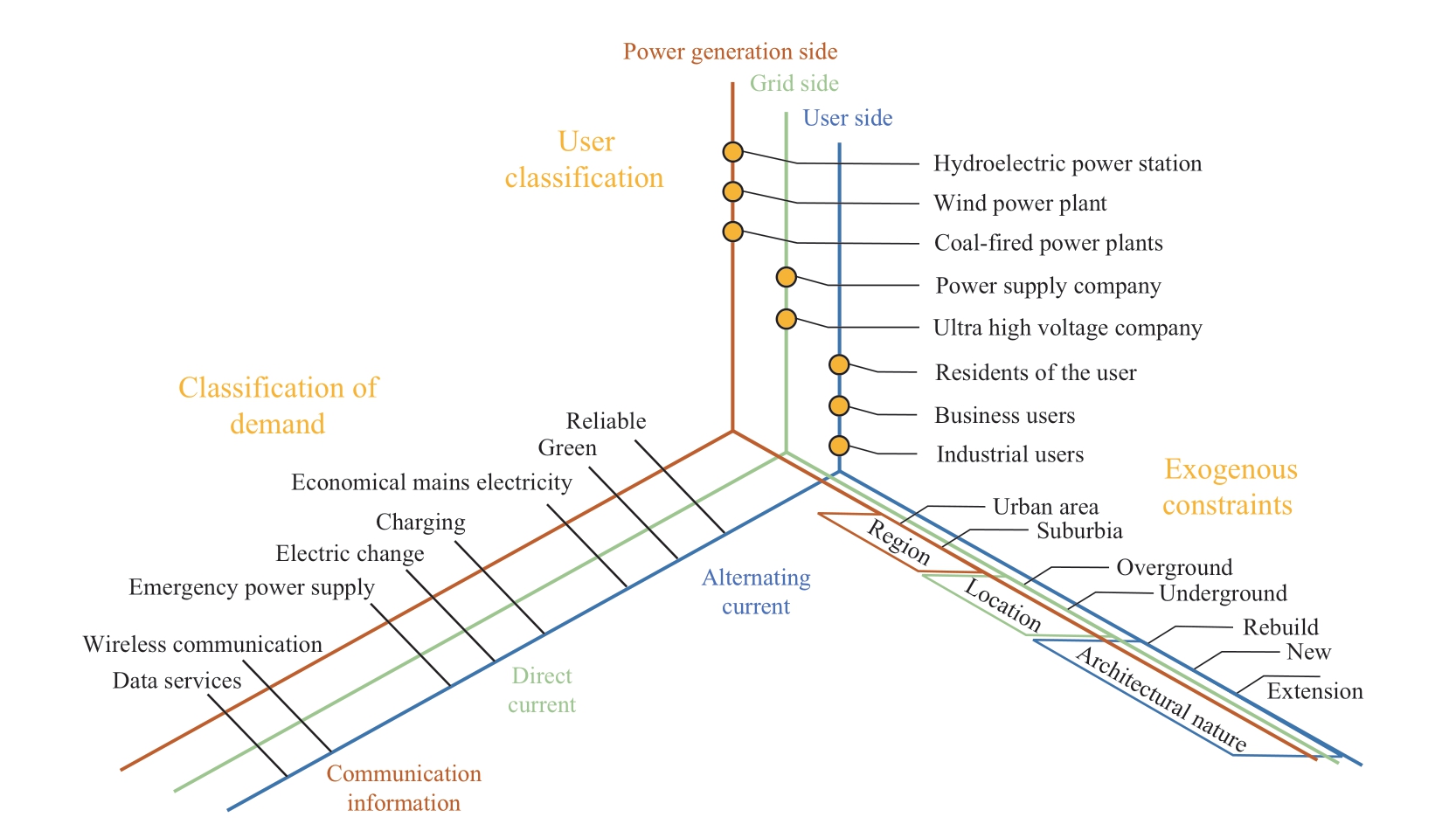
Fig.1 MSIES construction
Energy storage devices are widely used in MSIESs,and its application varies as per the user,as depicted in Fig.2:in the grid side,the energy storage devices are unable to participate in energy arbitrage.
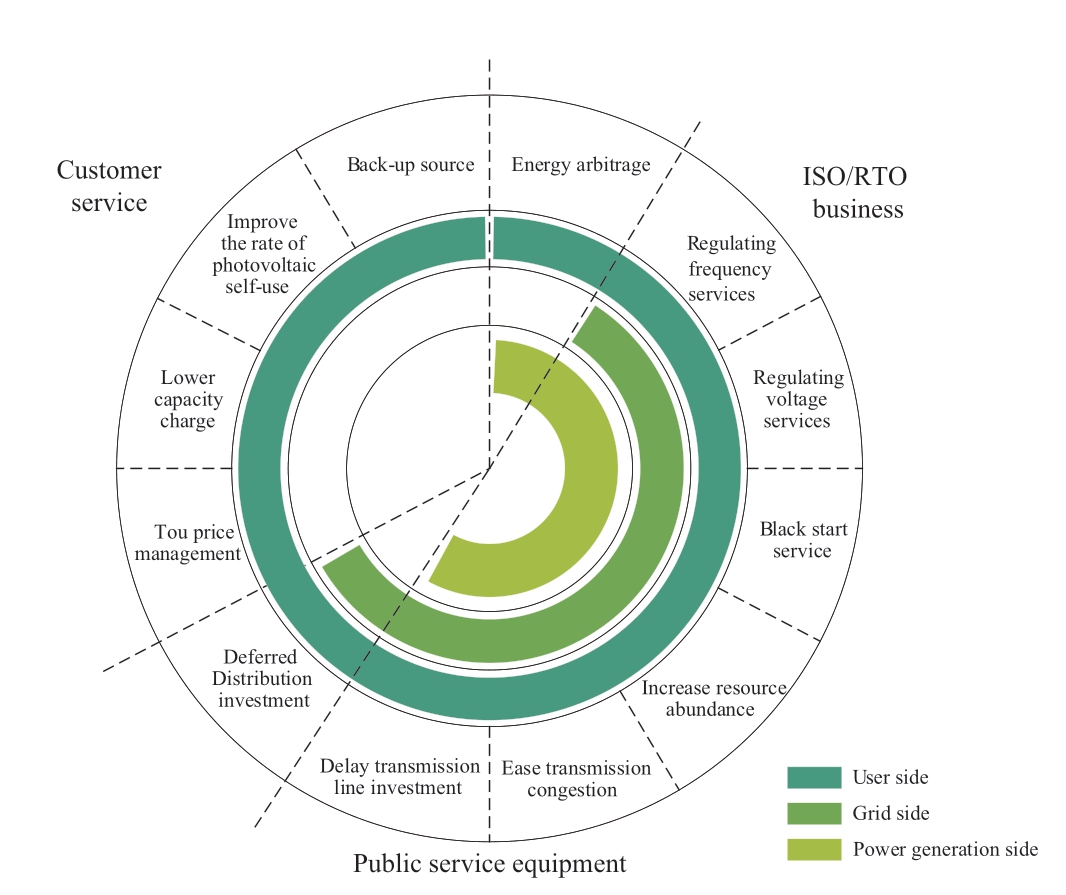
Fig.2 Application of energy storage in MSIES
1.2 Characteristics of each station
MSIESs is not only the aggregation of potential functions and value-added services of each function station,but also the integration of digital information and business models.The functional characteristics,configuration requirements,and integration schemes of each functional station are analyzed in Table 1.Among them,the data center station mainly considers power supply reliability (dual power supply),communication convenience,operation,maintenance,and user demand.Moreover,photovoltaic (PV)power stations mainly consider total radiation,atmospheric quality,and illumination time.Notably,the dust content of the atmosphere,i.e.,the concentration of particulate matter,which directly affects the photovoltaic conversion efficiency of solar panels.The charging station must consider the traffic flow,which directly affects the number of potential users and significantly impacts the derived economic benefits.
Table 1 Characteristics of each function station
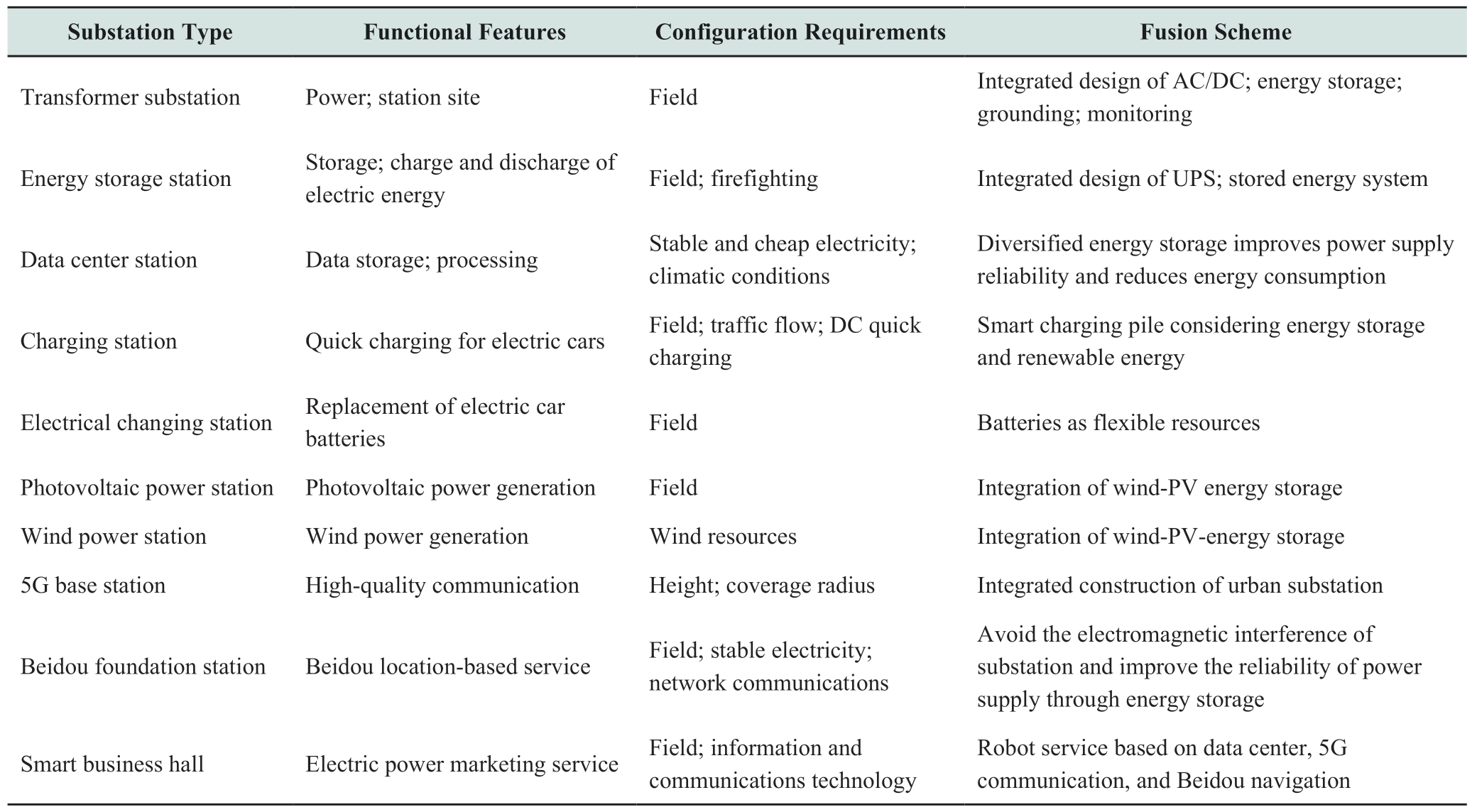
Table 2 Summary of supply and demand forecasting methods

2 Typical architecture of MSIESs
2.1 Features of MSIESs
MSIESs exhibit three characteristics: multi-energy complementarity,unification of three resource flows,and multiple interactions.
(1) Multi-energy complementarity: This system offers synergistic energy supply from wind,solar,and heat sources.The power supply side is transformed from a simple superposition of multiple energy sources to a multi-energy linkage offering systematic optimization and configuration on a spatiotemporal scale,which is based on the coordination of complex multi-energy flows in the network.Thus,the integration of various energy sources on the load side will effectively address the challenges of volatility and randomness caused by new energy access to the power grid,and it will significantly improve the reliability and efficiency of new-generation power supply systems in local areas.
(2) Three flows in one: MSIESs integrate the functions of energy storage stations and data centers to realize the synergy of energy,business,and data flows.They do not only support the future growth of data generated through internal businesses such as power grid operation and customer service,but also support the expansion of external business such as big data operations,energy finances,resource commercial operations,and virtual power plants.
(3) Multiple interaction: MSIESs offer the integration of production and sales with multiple loads.Considering the gradual shift in the nature of energy users from that of consumers to prosumers,which is facilitated by the bidirectional power regulation offered by the power grids,the new mode of multiple interaction,production,and marketing integration will continuously improve the network–load interaction ability and demand response ability of the power grids.
2.2 The overall architecture of MSIESs
The term “Multi-station” refers to the combined mode of “substation +X.” “Integration” refers to the integration of energy,information,and communication fields in business,the coordination of power grid enterprises and communication operators in service areas.The developmental stages of MSIESs are classified into three stages [27]:
(1) Subsystem development stage: Each subsystem is developed in the direction of intelligence,cleanliness,efficiency,and reliability.The physical connections between different energy systems are initially realized,and the core equipment to be developed is determined for the construction of a basic physical platform.
(2) Cross-system development stage: This stage involves transcending the physical barriers between energy systems and realizing internal energy circulation through the transformation between various energies.
(3) Platform level development stage: This stage involves the establishment of a unified platform,based on various emerging technologies such as blockchain and the price response mechanism of the energy market[28],promotion of efficient allocation of resources,and realization of a unified energy,information,and value flow.
MSIESs are characterized by abundant components,multiple subsystems,and considerable complexity.Their overall architecture requires a scientific top-level design,as depicted in Fig.3.The integrated design of subsystems is discussed in detail in the next section.

Fig.3 MSIES architecture
3 MSIES planning and design
3.1 Planning and design process
MSIESs can be classified according to the application scenarios: cities [29],rural areas [30],and industrial parks [31].These comprehensive projects for energy demonstration have yielded achievements in aspects such as the complementarity of wind–solar energy storage; however,these projects did not combine the energy consumption characteristics of energy storage stations,data center stations,and 5G base stations to plan and design the energy supply and consumption scenarios that meet the needs of different users and the integration stations that reflect local differences [32],which are crucial for achieving a balance between the supply and demand of energy systems.
The MSIES planning and design based on different types of functional stations [33–38]is conducted through five steps [39],as represented in Fig.4:
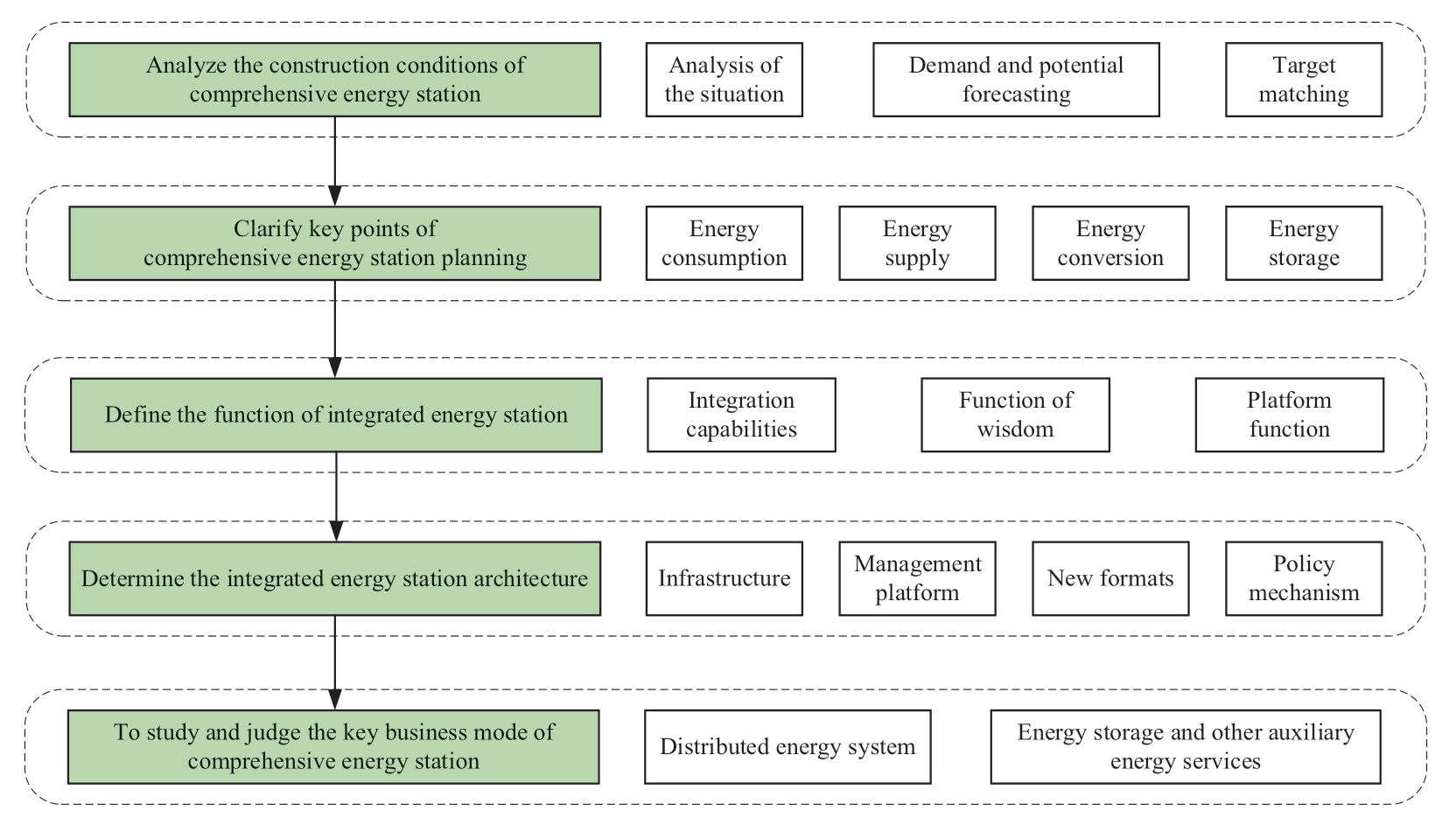
Fig.4 Design flow chart of MSIES
(1) Functions,including integration,intelligent,and platform functions,are defined.
(2) Structures are determined,including basic structures such as infrastructure,management platforms,new modes of operation and policy mechanisms,and additions and subtractions are made according to their own characteristics.
(3) Analyze the current state of development of the region where comprehensive energy stations are located.Subsequently,the state of development and energy demand of existing systems are determined,and the conditions for the application of new technologies are identified.
(4) The planning points of view from the four links of energy consumption,supply,conversion,and storage are established.
(5) Top-level design is conducted considering the aspects of important business forms such as micro-energy network-based distributed energy systems and auxiliary energy systems.
3.2 Subsystem of integrated design
In the overall MSIES architecture mentioned in Section 2.2,each substation has different requirements for AC and DC energy; thus,the AC and DC energy supply architecture should be comprehensively considered to achieve reliable and economic power supply.Currently,an integrated design in substation UPS,data center UPS,and energy storage is required for MSIESs.In addition,MSIES grounding systems must be considered,especially grounding for protection from lightning.
(1) Integration of station AC/DC power supply system.
The structure of MSIES power supply system includes both DC and AC buses.Therefore,the respective advantages of AC and DC power distribution technology can be effectively exploited [40].Moreover,PV,energy storage devices,and charging piles with DC characteristics can be directly connected to the DC buses,thereby reducing the conversion rings and system losses.In particular,the implementation of flexible and diverse forms of power supply,featuring efficient active and reactive power control,can resolve network problems such as voltage flicker and short-circuit current exceeding the standard.The DC architecture of MSIES is illustrated in Fig.5.
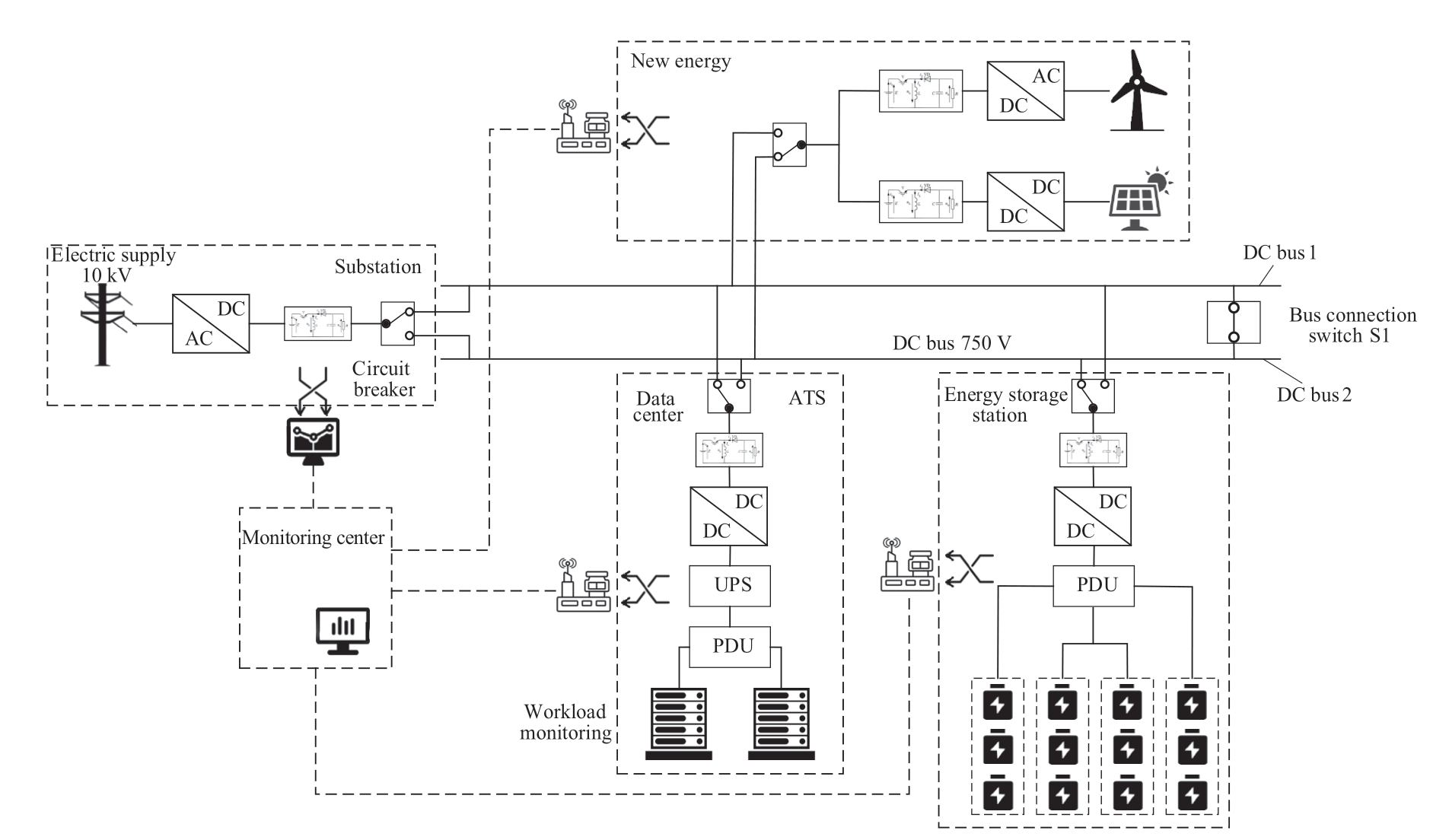
Fig.5 The DC architecture of MSIES
(2) Integration of energy storage station,substation UPS,and data center UPS.
Energy storage stations can replace the existing UPS systems used in substations and data centers.To ensure the reliability of power supply,the data center is equipped with a considerable scale of UPS for backup power supply in case of mains power failure.The extremely low utilization rate renders it a “sleeping asset” [41].If lithium batteries are used instead of lead-acid batteries,its capacity can be partially used for peak cutting and valley filling,and the remaining capacity can be used as a backup power supply,which can not only avoid the rapid capacity fading of lithium battery under the condition of large discharge depth,but also ensure its function as a backup power supply.This method employs the adequate capacity of lithium batteries for a backup power supply,which leverages the comprehensive benefits of the battery,considerably reduces the investment,and offers economic benefits [42].Therefore,during the construction of an integrated system,the energy storage station should not only realize peak shaving and valley filling,but also replace the functionality of the UPS used in the data center.
(3) Grounding system integration.
Different models of grounding systems and operating mechanisms of each functional station will lead to mutual influence,equipment damage,and bodily harm in the event of a short circuit or during lightning strikes.Therefore,the integrated construction of a grounding system can ensure the safe and stable operation of MSIESs.Notably,regardless of the grounding system: two-station integration,three-station integration,and multiple station integration,the safety of personnel and equipment in the event of a short circuit and lightning strike should be considered [43].
For new stations,each functional station must be constructed separately,and each station should be arranged in different buildings and the grounding grids should be connected via an appropriate number of conductors.Furthermore,the ground potential distribution between each grounding grid should be considered for the integrated construction scheme.If the potential difference exceeds the limit value,the number of conductors must be increased or each grounding grid must be built into a whole unit [44].
For the retrofitted station,when the scale of the new function station is small and the space available in the original substation building is sufficient for the retrofitting operation,the new function station and the original substation can be built in the same building [45].Furthermore,to reduce the impact of lightning current on the secondary equipment,the equipotential bonding of the newly added station equipment should be connected to the main grounding grid of the substation through down conductors [46].
3.3 Supply and demand forecast and capacity determination
Owing to the combined action of the fluctuation of distributed energy output and the randomness of userside load demands,all aspects of multi-station integration feature an element of uncertainty [47].Therefore,an accurate prediction method for the energy supply and consumption in multiple scenarios is a prerequisite to supporting multi-station integration planning.The supply and demand prediction methods of different types of functional stations at home and abroad are listed in Table 2.In particular,medium–long term prediction methods should be implemented in the multi-station integration planning stage.The power of wind turbine and PV generation will be affected by the wind speed and light intensity,respectively[48]; by incorporating the probability distribution characteristics of wind speed and light intensity,a random output model is established [49].Moreover,deep learning and other relevant methods provide a basis for accurate load forecasting.In essence,the refined prediction of renewable energy-related output data and multivariate load data in a medium–long-term time scale forms the basis of the MSIES planning and modeling stage.Notably,the implementation of artificial intelligence-based methods is expected to improve the practicability of the MSIES planning and operation model.
On the basis of the predicted energy supply and utilization,reasonable planning of the capacity of each functional station can improve the energy utilization efficiency and economy [60].In reference [61]the coupling relationship between electricity,heat,and gas was considered for the equipment selection and capacity configuration of an integrated energy system (IES).Reference [62]adopted a two-stage optimization method to plan a multi-area IES.In the first stage,the optimal installation capacity of various types of equipment is determined.On the basis of this calculated installation capacity,the optimal operation scheme of the system is determined in the second stage,and finally,the capacity configuration result of the system is obtained.The power demand subjects of MSIES are diverse,and the uncertainties of photovoltaic,wind,and load powers are large,which pose a great threat to the safety and operation of the power supply system.Notably,reasonable allocation of an energy storage system can effectively alleviate the aforementioned problems [63].In reference [64],for the selection of the optimal fluctuation mitigation algorithm,two fluctuation mitigation indexes were adopted,namely,the filtering percentage coefficient and average filtering amount,thereby realizing the optimal allocation of the storage battery capacity of the wind–solar combined output.Moreover,reference [65]considered multiple values of energy storage systems and aimed at deriving optimal comprehensive benefits of energy storage to establish a two-level planning model,thereby optimizing the configuration and operation strategy for shared energy storage.In reference [66],a comprehensive energy capacity optimization allocation method was proposed on the basis of the fruit fly optimization algorithm (FOA);aiming at a minimal monetary investment,a phased capacity optimization model was constructed,and the FOA was used to solve the model.Finally,the energy storage capacity is allocated on the basis of the obtained results.This model provides a new direction and idea for the construction of an MSIES,offering considerable practicability and operability.
The uncertainties of the energy supply side include the uncertainty of wind and sunlight and the uncertainty of the available state of the energy supply equipment.The power generated by a wind turbine is mainly determined by the wind speed.The power on the wind speed is expressed using a piecewise function as follows:

where Pr represents the rated power of the fan,vci symbolizes the cut-in wind speed,vco denotes the cut-out wind speed; vr indicates the rated wind speed.
Photovoltaic power is determined by the light intensity,which can be approximated as a beta distribution over a period of time:

where I(t) and Imax represent the light intensity at time t and the maximum light intensity in a period of time;α and β symbolize the shape coefficients of the beta distribution.
During the operation of the IES,the power supply equipment may fail,and the probability of failure of the equipment is expressed as:
Assuming the maximum and minimum values in the historical data of electric load in a certain period to be Pdmax and Pdmin,respectively,and the predicted value to be Pd,the uncertainty of electric and thermal load is expressed as follows:
In the case of a large number of integrated energy stations connected to the distribution network,the electricity demand of integrated energy stations is uncertain;accordingly,the planning problem is transformed into a constraint planning problem with random variables such as load in the constraint conditions.Aiming at the minimum sum of the annual investment and operation cost of the substation,the annual investment of the low-voltage side line,and the distribution network loss cost,the planning can be obtained as follows:

where CStation represents the annual investment and maintenance cost of substation converted to each year,CFeeder refers to the annual investment cost of low-voltage side line,CWs represents the annual network loss cost of low-voltage side line,P{·} represents the probability of the event in {·},α is the confidence level of given constraint conditions,ei represents the load rate of the i-th substation,cosφ represents the power factor,Ji and Pi represent the load set of the i-th substation,the capacity of the i-th substation,and the active power of the j-th load node,respectively,l(i,j)represents the straight-line distance between substation i and the supplied load j,N indicates the number of newly built substations,and Ri represents the maximum power supply radius of substation i under the combined limits of its capacity and load density within the power supply range.
4 MSIES operation control
MSIES is an advanced generation of intelligent energy system that enables systematic,integrated,and refined operation and management of energy production,transmission,and storage [67].As MSIES is an essential physical carrier of the energy internet,multi-energy complementation and energy cascade utilization should be achieved.
4.1 Model building
In general,various types of functional stations employ their own characteristic models such as integrated load model of substation [68],mathematical model and life model of energy storage station [69-70],PV and wind power output models [71],load model of charging stations[72],and hydrogen load demand models [73].Throughout extensive literature,these characteristic models manifest similar expressions,and the development of energy-use characteristic models is relatively mature.The operation constraints and control variables corresponding to various types of systems such as the energy storage state model of hydrogen energy storage system (HESS) can be represented based on an equivalent state of charge (ESOC):
where pvre denotes the residual pressure of the gas storage tank; pcap indicates the rated pressure of the tank.
Considering the superiority of the regulation ability of HESS under the premises of safety and stability,the ESOC should be classified into normal intervals:
In MSIESs,each function station does not operate independently,and the energy consumption characteristics of each function station should be integrated to construct a multi-energy complementary transformation model.The comprehensive energy complementary transformation model is an essential component of the MSIES operation.The relatively mature complementary transformation models include energy hub [74],combined cooling,heating and power (CCHP) system,and the combined heat and power (CHP) system,etc.To a certain extent,the current energy complementary transformation model fails to accurately reflect the state and characteristics of the system operation in actual operation [75].Therefore,further types of multi-energy complementary conversion models should be established to completely explore the factors affecting the multi-energy complementary conversion equipment under real working conditions.This will ensure the foundation of more accurate and idealistic multi-energy complementary conversion models,which further improve the accuracy of the simulation results.
Upon assuming that the IES operates in a steady state and neglecting the line loss,the energy conversion model can be formulated as
where L(t) represents all types of load demands at time t; θ denotes a matrix M × C,known as the coupling matrix,in which the element represents the coupling factor,indicating the ratio of the energy output of the i-th form to the energy input of the j-th energy converter.P(t) represents the input power of all converters; Qch(t) and Qdis(t) respectively describe the charge and discharge power of energy storage.
4.2 Multiple energy flow coordination control
(1) Multi-energy flow model
MSIES coordination control is an optimization process of multi-objectives and multi-fields,in which the overall efficiency can be improved through the coordinated control of resources in MSIES.Currently,no unified standard of integrated energy coordination control model exists for MSIES and multi-scenario conditions.In terms of combination mode,several scenarios are possible,e.g.,wind power + energy storage,solar energy + energy storage,and wind power + solar energy.Based on the degree of system regulation,the CPU load control and the temperature control at the data center may not be considered in the regulation process.According to the theoretical calculation model of equipment,the model form and parameter settings exhibit variations as well.Summarily,the coordinated control model should be multilevel and modular to improve the efficiency and feasibility of regulation.Although this ensures appropriate adaptability for improvement in model accuracy,the regulation model should avert the failure of the overall regulation strategy caused by the variations in the underlying model.
The coordinated control object of MSIES is formed by the energy flow expansion.Compositely,the coordinated control modeling of energy flow includes the combination of electricity,heat,and cold,the combination of energy system and communication information system,and the coupling of wind,light and hydrogen.Although MSIES contains various energy sources,it should primarily focus on the efficient utilization of electric energy.In particular,diverse energy sources are connected using a multi-energy complementary conversion system to achieve multiple energy conversions simultaneously.For multi-energy complementary conversion in MSIES,the energy router can realize the efficient utilization of energy in the network [76].The energy flow architecture of the IES with the energy router as the core is illustrated in Fig.6.
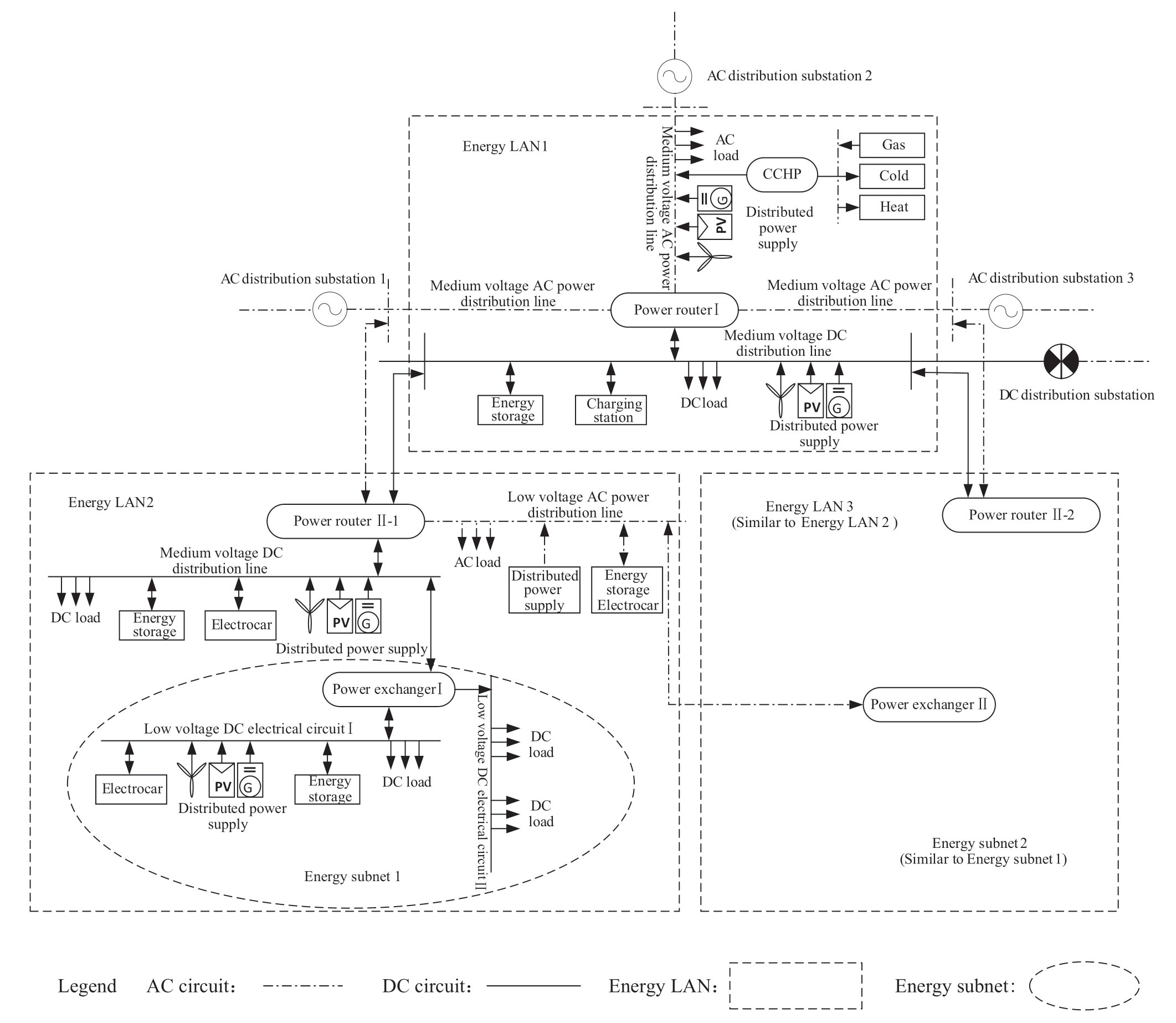
Fig.6 Energy flow architecture of integrated energy system based on energy router
The multiport energy router (MER) should adopt an advanced compensation strategy to realize seamless transition between grid-connected and island modes.At the instant the MER switches from the grid-connected mode to the island mode,the stability of DC voltage is controlled by the converter in the energy storage portion.To prohibit the influence on battery current and DC voltage during the transition process,the voltage loop and internal current loop of the energy storage component should be calculated in advance,which are expressed in Equations (9) and (10),respectively.

where Iswitch and Dswitch denote the theoretical regular output values of the PI controllers in the outer DC voltage loop and inner energy storage inductor current loop,respectively.Ubat and UMD represent the average voltages of energy storage battery and DC component during the mode switching process,respectively.Pswitch accounts for the net consumption power at the switching moment.
At the instant the MER switches from the island mode
to the grid-connected mode,the influence on the power grid current and medium-voltage DC voltage during the transition process is prevented by coinciding d-axis of the rotating coordinate system with the composite vector of the three-phase power grid voltage,which can be derived as
where Id-switch denotes the theoretical steady state output values of the controller in the outer DC voltage loop,and Ed represents the grid voltage d-axis component.
Horizontal connection of multiple links can yield the optimal utilization of comprehensive energy.The term“horizontal multi-source complementarity” refers to the complementary coordination among various energy resource systems such as those pertaining to electricity,gas,cold,and heat,thereby highlighting the “substitutability”of various energy resources,which is a key approach for addressing the challenges of low quality and low efficiency.Conversely,multiple energy sources can be used as backup for each other through high-efficiency conversion devices,thereby effectively eliminating any interruptions in the energy supply and improving the quality of the energy supply.However,different energy sources possess different characteristics,and the efficiency of comprehensive energy utilization can be effectively improved by complementing each source’s characteristics.
Integrated energy management and services can be achieved through vertically layered collaboration.The term“vertical source–grid–load–storage coordination” refers to the mutual coordination between the supply,conversion,consumption,and storage of energy resources,which further expands the demand-side management to integrated energy management in the whole energy field and offers refined and customized integrated energy services to users.
(2) Cooperative control strategy
The MSIES executes different coordinated control strategies for different scenarios: coordinated control strategy for renewable energy considering peak shaving to reduce resource cost,integrated system coordinated operation strategy considering controllable resource risk [77],regulation strategy of electric vehicle charging station in multi-station integration scenarios,and coordinated control strategy of specific topology structure.In the coordinated control of multiple energy flows in an IES,the control strategy was implemented for the energy router [78].Moreover,the topology of an energy router generally comprises three layers: the input layer,isolation layer,and output layer.Particularly,each layer adopts different topologies and different control strategies.By connecting the devices in the integrated energy station to the interface of the energy router,the overall coordinated control can be realized through the control of each interface and the transformation of the internal power supply of the energy router.
Based on the current trigger instructions,the energy router operates in a specific working condition to maintain the power balance and voltage stability in the system.In the transition process of working condition switching,the unbalanced energy,flowing into the DC bus,is fully absorbed by the DC bus capacitor,and the fluctuation of bus voltage depends on the magnitude of the unbalanced energy,as demonstrated in Equation (12).
where Pei represents the power of the voltage source converter,photovoltaic system,energy storage,and other devices that flows into the DC bus,c symbolizes the DC bus capacitance; uc1 and uc2 indicate the DC bus voltages before and after the switching of the working mode.
If the coordinated control strategy were to ensure the real-time power balance of each port in the process of working condition switching,then the fluctuation of bus voltage would be minimal; this attribute can help eliminate the bus voltage jump caused by the energy mismatch in the transition process resulting from the power jump in the traditional working condition switching process,thereby enabling seamless switching between different working conditions.Thus,the system is always supported by a voltage source under any working condition: when the energy storage or electric vehicle is to be cut off or cut into,the operation can be executed when its reference current is zero.For instance,to remove the energy storage,the reference current of the energy storage (as expressed in Equation (13)) must be controlled: it should be decreased linearly and rapidly to zero.
where I1 denotes the actual steady-state current value ranging from the last working condition to the moment of switching,t0; k1 represents the slope of current change.
4.3 Safe operation technology
(1) Situational awareness
The comprehensive,timely,and accurate perception and self-adaptive adjustment of the equipment status are the prerequisites for ensuring the safe operation of MSIESs.Currently,the situational awareness technology in the power system is relatively mature; however,in an IES with a high proportion of new energy and high proportion of access to power electronic equipment,the pace of research on situational awareness technology at home and abroad has been relatively slow,and it is mostly focused on specific environments.Therefore,the challenges related to the real-time perception of equipment status,accurate assessment,and timely warning of potential faults under complex changing conditions must be addressed,and the failure mechanism and laws of power equipment under extreme conditions,long-term service,and maintenance strategies must be investigated.These measures will enable the lean management and efficient maintenance of power equipment and ensure the safety and reliability of long-term operation of power equipment under complex operating conditions.
Focusing on the main requirements of reliability,high efficiency,and energy-saving operation of equipment under complex operating conditions,the research and application of digital and intelligent technology for power equipment are represented through the Internet of Things (IoT),big data and artificial intelligence,and digital twinning of power equipment.Based on these advancements,key technologies such as those used in the assessment of new equipment status and efficient utilization of equipment should be further investigated.Moreover,a technical system for the operation and maintenance of equipment should be formulated to provide a scientific basis and technical support for equipment situational awareness and efficient and safe operation.
(2) Security assessment
For the safety assessment of equipment in MSIESs,the methods of health assessment for batteries used in largescale energy storage systems mainly include physical model and style="font-size: 1em; text-align: justify; text-indent: 2em; line-height: 1.8em; margin: 0.5em 0em;">Regarding the security assessment of MSIESs,the existing methods for resilience assessment,load recovery strategies,and resilience improvement have been reviewed through the resilience assessment of an urban IES [79].Additionally,a reliability evaluation method of distributed PV and storage power system has been proposed for household power outages [80].Moreover,a safety evaluation index and comprehensive evaluation index have been proposed for MSIESs [81].Furthermore,the working and fault conditions of each component were simulated via a sequential Monte Carlo algorithm,and the cumulative power-out time of each power-out load was calculated[82].As the capacity of the energy storage station has been improved steadily,the overall power supply reliability of MSIESs and the power supply reliability of the data center have been steadily improved: the average service availability index (ASAI) was improved from 99.841%to 99.905%,and the system average interruption duration index was improved from 99.715 to 99.827%.
The ratio of the average number of hours of data center power per year to the total number of hours required is recorded as the data center’s ASAI,RASAI.
where Ta represents the annual operating hours.
Essentially,the research concerning the comprehensive safety assessment of power stations at home and abroad have demonstrated preliminary progress; however,a comprehensive evaluation method for energy systems that considers the IES as the main body,incorporates the coupling characteristics of multi-energy networks and the dynamic characteristics of different energy networks,and takes into account different energy load priorities and energy levels,is yet to be determined.
5 MSIES power market
5.1 Business model
A reasonable and operable business model is a prerequisite for the sustainable development of MSIESs to support and realize the reasonable distribution of value among multiple investors and users,and promote participation of all parties in the investment and operation of MSIESs.Business model innovation is the process of innovative design of business model elements.The business model of MSIESs is illustrated in Fig.7.The positive results of business model innovation include the commercialization of new technologies,development of enterprise core capabilities and expansion of the business boundaries and application scenarios [83].In particular,technological innovation drives business model innovation,which necessitates the introduction of technology to the market and market opportunities to meet the potential needs of consumers.Successful business model innovation can yield new capabilities for enterprises,thereby improving their capabilities and yielding competitive advantages.Business model innovation can help enterprises expand their transaction boundaries,introduce new partners and new value-added services into the value network,and achieve win–win cooperation among different stakeholders.IoT and blockchain technologies support the digital transformation of power grid enterprises and provide a platform for multiple entities to participate in the market fairly and efficiently allocate resources at all levels.Third-party independent entities can not only participate in the market independently as operating entities,but also participate in auxiliary services and other application fields in an aggregated way.A format for market organization has been proposed with energy service providers,information operators,and IES platforms as the main participants; the business model was constructed to meet the diversified energy demand of users,the supply and demand sides were actively linked to match the transaction,the market behavior of each subject was guided as the core,and the operation characteristics and operation core of each market subject in different market stages was analyzed [84].Reference [85]focused on the three emerging business categories of energy transformation business,new energy digital product,and new energy platform service,and employed the business model iteration system to explore the application of a differentiated iteration system.

Fig.7 Business model
According to the characteristics of multi-energy complementarity,multi-network coupling,green electricity access,supply–demand interaction,and high integration of“source–network–charge–storage” energy and information,MSIESs combine the resource view,strategic network,enterprise boundary,and transaction cost of the business model.The evaluation criteria that can promote the healthy development and standardization of its business format should be formulated on the basis of the value-creation scheme,benefit-distribution mechanism,and business strategy.Moreover,the business model should not only pay attention to the economic value,but also consider the transmission of social value.Particularly,an evaluation index system has been proposed on the basis of energy utilization,energy coupling efficiency,cost-effectiveness,risk control,and social responsibility [86].Additionally,a comprehensive system for evaluating the energy efficiency was established,including macro energy efficiency(energy efficiency and renewable energy utilization ratio),micro energy efficiency (charging station energy efficiency and data center energy efficiency) and energy economic indicators (energy economic cost and economic development adaptability) [87].
Furthermore,reference [88]constructed subsystems on the basis of the business classification,developed a system dynamics model guided by the business operation of the project,simulated the changes in economic,environmental,and social benefits of MSIES projects,and analyzed MSIESs in different scenarios.The change trend of the economic,environmental,and social benefits of the project fully reflects the interaction process of variables at the micro level.Notably,different businesses can meet the expected economic benefits under certain conditions.The factors influencing the economic benefits of different services in MSIES are distinct: the factor influencing the energy services is the charging volume,and the main factor influencing information and leasing services is the rate of cabinet erection.Moreover,the environmental benefits represent an “induced effect” of the energy business in MSIES,which can help improve the efficiency of waste and reduce exhaust emissions.Furthermore,the social benefits are mainly reflected in the three aspects of social capital savings: land resources,energy resources,and human resources.
In reference [89],the investment operation for an MSIES was evaluated on the basis of the SWOT analysis model.The results indicate that in terms of investment and operation subjects,investments should be made through provincial and municipal companies (main business investment) and provincial communication companies as the operation subjects for the commercial operation of MSIESs;in terms of the operational strategy,diversified strategies should be adopted to cope with external competition under the premise of expanding investment and operation.
5.2 Spot market
The construction of the electricity spot market is crucial to strengthening the reform of the current electricity distribution system.Particularly,the relatively perfect foreign power market system is not suitable for China’s market environment [90].The advent of the domestic electricity spot market is a recent phenomenon,and further improvements are required for the market mechanism.Moreover,the scientificalness and feasibility of different electricity price systems should be further investigated.Considerable research has been conducted on the power spot market; these research focus on the pricing method [91],clearing mechanism [92],peak shaving [93]and frequency modulation auxiliary service market [94],business platform design [95],forward-looking optimization [96],and revenue sharing [97].By summarizing the experience of power spot market construction at home and abroad,great differences were discovered in the structure of the power market in different countries and regions as well as in different domestic provinces.The construction of the country’s electricity spot market remains in the exploratory stage and is stymied by several challenges and risks [98].The spot market should be gradually adapted to local conditions.On the basis of the findings on foreign spot market construction and renewable energy consumption,the country’s electricity spot market should be completely apprehended.In accordance with the actual situation of construction,the construction of the country’s electricity spot market should be wholly promoted in an orderly manner [99].For MSIESs,to improve the consumption of renewable energy and promote energy conservation and emission reduction,the value of energy trading must be tapped,modes of multienergy cooperative trading must be explored,and the benign and positive development of multi-energy trading must be promoted through market measures.
Before the advent of the electricity market reform,park users usually adopted the industrial and commercial stepped electricity prices,and the electricity prices were assumed to be constant during the economic optimization operation [100].In the environment of the electric power spot market,the electricity prices change dynamically according to the supply–demand relationship and network congestion,and vary with the progression of time [101].In addition to obtaining power supply through the power grid,MSIESs generally include multiple types of energy supply equipment such as photovoltaic equipment,CHP/CCHP units,boilers,and energy storage devices [102]as well as energy service providers (ESP) [103].The ESP acts as a middleman.Externally,it is responsible for participating in electricity market transactions,authorizing contracts pertaining to electricity purchases,directly participating in spot market trading activities,and accepting electricity assessments from the power grid dispatching department.Internally,it is responsible for operating the energy supply facilities in the station and arranging the energy supply in the park to achieve the goal of optimal economy on the premise of guaranteeing the supply.The electricity market mainly includes medium- and long-term markets and the spot market; particularly,the medium- and long-term price anchors the spot price of electricity.The spot market reflects the real situation of power system operation through realtime price and provides a price benchmark for medium- and long-term electricity transactions; it generally comprises three market stages: day-ahead,intra-day and real-time stages [104],thereby realizing a multi-step,progressive,and economic approach to rolling optimal scheduling.According to the existing rules governing the electricity market,the operation mode of an MSIES participating in the electricity spot market is illustrated in Fig.8.
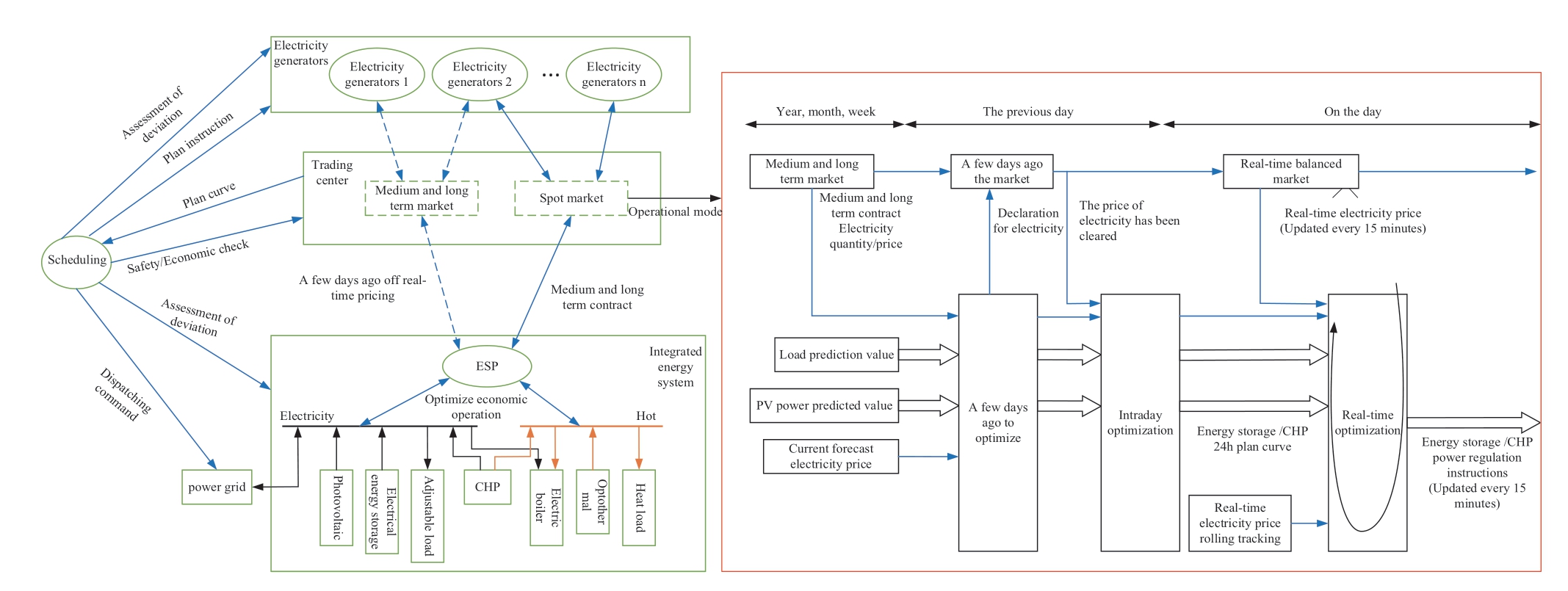
Fig.8 Operation mode of MSIES participating in electricity spot market
In the day-ahead optimization phase,the ESP invariably reports the time-sharing load curve of the next day to the spot market daily according to the predicted value,which will directly affect its earnings in the spot market.In the intra-day optimization stage,the clearing price is released,and the spot price in the day-ahead market is finally determined.Before initiating the real-time operation,the optimization calculation that was conducted in the electricity declaration stage must be revised to arrange the MSIES intra-day electricity generation plan in advance.After entering the real-time stage,with the rolling optimization clearing method adopted by the spot day real-time market,the rolling optimization is conducted synchronously in the day real-time stage.Considering a period of 15 minutes as the cycle,the internal power-generation plan curve of the IES and the latest real-time market price are updated.
The participation of the ESP in the power market is generally aimed at profit maximization,and the objective function expressed in Formula (16) is established on the basis of comprehensive consideration of different equipment characteristics,equipment operating costs,and various service benefits.
where Ri refers to the service income of frequency and voltage regulation,system backup,and black-start support,Cj represents the cost of equipment operation and maintenance,annualized investment,and depreciation of assets; λ denotes the compatibility coefficient between different applications.
6 Prospect
The MSIES demonstration projects such as the Wuxi 220 kV Hongqi substation,Shenzhen 110 kV Chuangxin substation,and Shanghai 110 kV Yinjiabang substation were put into operation; the key technologies of MSIES architecture,planning and design,operation control,and market operation were verified through these projects.MSIES fusion represents a new type of business and is currently in the process of rapid development.The development of other typical applications will also promote and enrich MSIESs,mainly including the following aspects:
(1) Power-to-X (PTX) and energy storage: the technological breakthrough and application of PTX and energy storage in flexible conversion and demand-side management can effectively solve the contradiction between the intermittent nature of renewable energy and the rising demands for clean energy.This breakthrough enhances the persistence of the energy system,strengthens the integration and effective interaction of multi-energy systems,yields high-speed transmission and collaborative optimization,and promotes the construction of an energy internet featuring the power grid as the hub.
(2) Digital twin grid (DTG): the DTG is a virtual mapping and intelligent control measure for physical power grid facilities,forming a complex giant system with virtual–real correspondence,mutual mapping,and collaborative interaction to solve the complexity and uncertainty of power grid facilities in the planning,construction,operation,management,and service process.The application of modeldriven DTG and style="font-size: 1em; text-align: justify; text-indent: 2em; line-height: 1.8em; margin: 0.5em 0em;">(3) Virtual power plant and energy blockchain: the virtual power plant renders the power grid as a platform for the aggregation and sharing of adjustable resources on the customer side,thereby realizing “demand elasticity,supply,and demand synergy” and optimizing the overall resource utilization efficiency of the society.MSIESs possess a large number of flexible resources and can actively use virtual power plant technology to participate in the market.Moreover,the energy blockchain possesses the characteristics of decentralization,tamper-proofing,and privacy protection.It can be used to construct a convenient,efficient,interactive,fair,and credible universal blockchain service platform to address the challenges involved in terms of multiple participants and lack of trust in MSIESs.
Acknowledgements
This work was supported by Science and Technology Project of SGCC(No.5400-202017203A-0-0-00)and National Natural Science Foundation of China(No.92067105).
Declaration of Competing Interest
We declare that we have no conflict of interest.
References
[1]Cui H Z,Yang B,Tang Y M,et al.(2020) Design of the architecture and project of comprehensive energy hub under the background of multi-station integration.Distribution &Utilization,37(8): 16-20
[2]Alibaba D A.(2022) Top ten technology trends of damo academy.Hangzhou.
[3]Jiang X C,Xu Y P,Li Y C,et al.(2022) Digitalization transformation of power transmission and transformation under the background of new power system.High Voltage Engineering,48(1):1-10
[4]Liu Y D,Chen S,Cong Z H,et al.(2021) Key technology and application prospect of digital twin in power equipment industry.High Voltage Engineering,47(5): 1539-1554
[5]Jiang B (2021) Building new power system for 30·60 –reflections on China’s electricity 4.0.Journal of Global Energy Interconnection,4(6):534-541 (in Chinese)
[6]Du Y,Lin H Y,Xiang K L et al (2019) Research on the index system of economic activity analysis under electricity reform.IOP Conference Series: Earth and Environmental Science,267(4): 042139
[7]Li K X,Guo H Y,Chen Q X.(2021) Integration and collaboration of electricity market from perspectives of electricity restriction accident in California and mechanism of western energy imbalance market in USA.Automation of Electric Power Systems,45(10): 1-8
[8]Xiao Y P,Wang X F,Wang X L,et al.(2020) Review and prospects of coupled transactions in multi-carrier energy systems.Journal of Global Energy Interconnection,3(5): 487-496 (In Chinese)
[9]Wu B,Zhang S H,Wang X,et al.(2022) Equilibrium strategy analysis for demand response of integrated energy service provider participating in multi-energy market transaction.Power System Technology,46(5): 1800-1809
[10]Wang Q,Li N,Gu X,et al.(2022) Optimization strategy for cooperative operation of integrated energy service providers considering carbon emission reduction.Automation of Electric Power Systems,46(7):131-140
[11]Gao Z Y,Zhang J,Shi S H,et al.(2021) Research on electricity market standard system facing energy internet.Distribution&Utilization,38(7): 9-13,27
[12]Yang Z L,Zeng D,Feng S H,et al.(2022) Challenges and critical techniques of electricity market experiment capability construction.Automation of Electric Power Systems,46(10):111-120
[13]Nathalie Thomas.(2020) UK trials peer-to-peer energy trading.Financial Times.https://www.ft.com/content/6d62b494-209a-11e9-b126-46fc3ad87c65.Accessed on 20 May 2022
[14]Zhao J Q,Yang Y H,Sun Z H,et al.(2020) Deep peak regulation market mechanism and clearing model considering participation of virtual power plants.Journal of Global Energy Interconnection,3(5): 469-476 (in Chinese)
[15]Zhang Y J,Gu C H,Li F R (2020) Optimal strategy for local energy trading considering network charges and renewable uncertainties.Journal of Global Energy Interconnection,3(5):461-468 (in Chinese)
[16]Kong P H,Jiang Z W,Yang L Q,et al.(2022) Mechanism and risk quantification model design of hydrogen storage system participation in power market.Distribution & Utilization,39(1):31-39
[17]Zhao J Q,Sun Z H,Yang Y H,et al.(2020) Study on frequency regulation ancillary service trading mechanisms for distributed photovoltaic generation.Journal of Global Energy Interconnection,3(5):477-486 (in Chinese)
[18]Ge R L T,Zhang L H,Chai J X.(2020) Cooperative game model of energy storage power station and photovoltaic power station in power market environment.Renewable Energy Resources,38(4):545-553
[19]Zang H X,Ma M X,Zhou Y Z,et al.(2022) Robust optimal scheduling model for a ‘wind power-concentrating solar powerbiomass’ hybrid power plant in the electricity market.Power System Protection and Control,50(5): 1-11
[20]Ma H M,Li X J,Jia X C (2021) Capacity configuration and coordinated operation strategy in the multi-station integration scenario.Electric Power Construction,42(1): 96-104
[21]Chen Y,Jin W,Wang W B,et al.(2020) Multi-station fusion power supply system to assist peak regulation strategy.Power System Protection and Control,48(20):57-65
[22]Zhou X,Liu J M,Chu N,et al.(2020) Research on AC/DC micro-grid system in multi-station fusion project of smart energy station.Electrical Measurement & Instrumentation,59(6): 27-31,68
[23]Xu W B,Cheng H F,Bai Z H,et al.(2019) Optimal design and operation of energy storage power station under multi-station fusion mode.Distribution & Utilization,36(11): 84-91
[24]Xie Z,Tang H W,Han X Y,et al.(2021) Duopoly benefit distribution mechanism under multi-station integration based on Stackelberg model.Power System Technology,45(10): 4009-4015
[25]Li X R,Wang J,Ding J M,et al.(2020) Optimal sizing and locating of multi-functional integrated substation based on Voronoi diagram.Power System and Clean Energy,36(2): 44-54
[26]Liu Q Q,Liu P K,Sun Y K,et al.(2021) Screening mechanism for priority business of multi-station integration project based on random forest algorithm.Smart Power,49(6): 32-39
[27]Wang Y Z,Kang L G,Zhang J,et al.(2021) Development history,typical forms and future trends of integrated energy system.Acta Energiae Solaris Sinica,42(8): 84-95
[28]Gong T J,Wang H J,Yang S,et al.(2020) Integrated energy service based on blockchain technology.Proceedings of the CSEE,40(5): 1397-1409
[29]Xie S,Jia Y L,Bai X T,et al.(2021) A review of tools for urban energy systems planning and energy consumption analysis.Journal of Global Energy Interconnection,4(2): 163-177 (in Chinese)
[30]Li J X,Wang D,Jia H J,et al.(2021) Prospects of key technologies of integrated energy systems for rural electrification in China.Global Energy Interconnection,4(1): 3-17
[31]Zhong C L,Li K M,Xu M Z,et al.(2018) Real time monitoring and online analysis of integrated energy in industrial park based on SVG and Ajax.2018 3rd International Conference on Smart City and Systems Engineering (ICSCSE).Xiamen,China.IEEE,605-608
[32]Jiang C F,Ai X.(2019) Review on integrated energy system collaborative planning methods for industrial park.Journal of Global Energy Interconnection,2(3): 255-265 (in Chinese)
[33]Zhang Q,Zhu X J,Li Z S,et al.(2021) Research on the operation mode of energy integrated service station under multi-station integration.2021 6th Asia Conference on Power and Electrical Engineering (ACPEE).Chongqing,China.IEEE,1077-1081
[34]Li Y,Ye Y Z,Li H,et al.(2021) Scenarios analysis and energy supply optimization configuration for multi-station integration.2021 6th Asia Conference on Power and Electrical Engineering(ACPEE).Chongqing,China.IEEE,1367-1371
[35]Zhang M Z,Li X C,Hua S H (2021) Capacity planning and economic benefit analysis of multi-station integration.2021 IEEE 4th International Electrical and Energy Conference.Wuhan,China.IEEE,1-4
[36]Ma X F,Zhu Q P,Duan Y,et al.(2022) Optimal configuration of 5G base station energy storage considering sleep mechanism.Global Energy Interconnection,5(1): 66-76
[37]Lu X J,Wang J,Liu G,et al.(2021) Station-and-network–coordinated planning of integrated energy system considering integrated demand response.Global Energy Interconnection,4(1): 39-47
[38]Zhang C,Zhang Y,Chen J,et al.(2020) Research on combination modes and adaptability analysis of multi-station integration.2020 5th International Conference on Power and Renewable Energy(ICPRE).Shanghai,China.IEEE,538-542
[39]Zhou X X,Zhao Q,Zhang Y Q,et al.(2021) Integrated energy production unit: An innovative concept and design for energy transition toward low-carbon development.CSEE Journal of Power and Energy Systems,7(6): 1133-1139
[40]Qiu M Y,Jiang B K,Kong L D,et al.(2021) Design of AC and DC power supply system for multi-station integration.2021 4th International Conference on Energy,Electrical and Power Engineering (CEEPE).Chongqing,China.IEEE,1113-1118
[41]Cao F,Wang Y J,Zhu F,et al.UPS node-based workload management for data centers considering flexible service requirements.IEEE Transactions on Industry Applications.IEEE,5533-5542
[42]Jones M,Peet M M (2021) Extensions of the dynamic programming framework: Battery scheduling,demand charges,and renewable integration.IEEE Transactions on Automatic Control,66(4): 1602-1617
[43]Cai Y X,Lei X,Yuan S Q,et al.(2021) Research on integration construction and safety of grounding system in three-inone station.2021 6th International Conference on Power and Renewable Energy (ICPRE).Shanghai,China.IEEE,1315-1320
[44]Jiang B K,Qiu M Y,Kong L D,et al.(2021) Research on the construction of integrated grounding grid of substation and energy storage station.2021 6th International Conference on Power and Renewable Energy (ICPRE).Shanghai,China.IEEE,1254-1259
[45]Cai Y X,Ji H,Wang D W,et al.(2021) Optimal construction method and demonstration application of multi-in-one station grounding system.Global Energy Interconnection,4(5): 520-530
[46]Qiu M Y,Jiang B K,Kong L D,et al.(2021) Research on equipotential construction of multi station integrated data center.2021 6th International Conference on Power and Renewable Energy (ICPRE).Shanghai,China.IEEE,787-791
[47]Han X Q,Li T J,Zhang D X,et al.(2021) New issues and key technologies of new power system planning under double carbon goals.High Voltage Engineering,47(9): 3036-3046
[48]Sanjari M J,Gooi H B,Nair N K C (2020) Power generation forecast of hybrid PV–wind system.IEEE Transactions on Sustainable Energy,11(2): 703-712
[49]An Y,Zhao Z,Wang S K et al (2020) Coordinative optimization of hydro-photovoltaic-wind-battery complementary power stations.CSEE Journal of Power and Energy Systems,6(2): 410-418
[50]Zhao S Q,Hu L N,Tian J F,et al.(2019) Contract power decomposition model of multi-energy power system based on medium and long-term wind power photovoltaic forecast.Electric Power Automation Equipment,39(11): 13-19
[51]Wang K,Liu H (2022) Key technologies and applications of big data platform construction for new energy multi-service scenarios.Journal of Global Energy Interconnection,5(2): 157-165 (in Chinese)
[52]He M (2020) Study on influencing factors and forecasting methods of medium and long-term power generation of distributed PV power stations.Dissertation,Zhejiang University of Technology
[53]Han S,Qiao Y H,Yan J,et al.(2019) Mid-to-long term wind and photovoltaic power generation prediction based on copula function and long short term memory network.Applied Energy,239: 181-191
[54]Wang C D,Yuan J J,Zhang J,et al.(2020) Multi-criteria comprehensive study on predictive algorithm of heating energy consumption of district heating station based on timeseries processing.Energy,202(22): 117714
[55]Luo S X,Ma M H,Jiang L,et al.(2020) Medium and longterm load forecasting method considering multi-time scale data.Proceedings of the CSEE,40(S1): 11-19
[56]Yang N,Li H S,Yuan J Y,et al.(2018) Medium- and long-term load forecasting method considering grey correlation degree analysis.Proceedings of the CSU-EPSA,30(6): 108-114
[57]Li D H,Yin H Y,Zheng B W.(2018) An annual load forecasting model based on generalized regression neural network with multi-swarm fruit fly optimization algorithm.Power System Technology,42(2): 585-590
[58]Chen F X,Xu J Q,Wang C Y,et al.(2015) Research on building cooling and heating load prediction model on user’s side in energy internet system.Proceedings of the CSEE,35(14): 3678-3684
[59]Shen X W,Guo Q L,Xu Y L,et al.(2019) Robust planning method for regional integrated energy system considering multienergy load uncertainties.Automation of Electric Power Systems,43(7): 34-41
[60]Li Y,Zhang Z Q,Luo R,et al.(2020) Integrated energy system planning method combined with microgrid operation mode.Smart Power,48(6): 40-46
[61]Lei J Y,Yu L,Guo X B,et al.(2019) Planning method for integrated energy system with the consideration of coupling among power,heat,and gas.Proceedings of the CSU-EPSA,31(1): 19-24
[62]Fan H,Yuan Q Q,Deng J.(2020) A two-stage optimal capacity configuration of multi-region integrated energy system.Modern Electric Power,37(5): 441-449
[63]Xiao H,Pei W,Dong Z M,et al.(2018) Bi-level planning for integrated energy systems incorporating demand response and energy storage under uncertain environments using novel metamodel.CSEE Journal of Power and Energy Systems,4(2):155-167
[64]Qiu C,Li Y N,Song R C,et al.(2020) Optimization configuration of energy storage capacity of wind and photovoltaic generation system.Water Resources and Power,38(5): 202-206
[65]Pan Q H,Lin J Q,Sun W Q (2020) Configuration and operation strategy of shared energy storage considering multi-body power load uncertainty in industrial parks.Computer Engineering &Software,41(7): 260-263,296
[66]Mao Z B,Zhou J,Chen Q,et al.(2021) Research on optimal allocation of integrated energy system capacity and its economic benefits.Price: Theory & Practice,(3): 138-141,168
[67]Qu M,Ding T,Jia W H,et al.(2021) Distributed optimal control of energy hubs for micro-integrated energy systems.IEEE Transactions on Systems,Man,and Cybernetics: Systems,51(4):2145-2158
[68]Zhu W G,Zhang C S,Xiong N,et al.(2019) Chance-constrained programming for distribution substations considering uncertainty of electric load in comprehensive energy stations.Electric Power Construction,40(8): 19-25
[69]Meng C,Liu W L,Yang Q,et al.(2020) Research on operation optimization of edge data center under the background of “multistation integration”.Advanced Engineering Sciences,52(4): 49-55
[70]Bai Z H,Li Q,Chen J,et al.(2021) Operation strategy optimization of energy storage power station in multi-station integration scenario.Electric Power,54(6): 136-144
[71]Zhu L L,Xiao C P,Ding S,et al.(2021) Day-ahead optimal operation of multi-station fusion system considering carbon emission.Power Demand Side Management,23(5): 40-45
[72]Liang J,Zhao X G,Yang S D (2021) Collaborative optimization model of renewable energy development considering peak shaving costs of various flexibility resources.Global Energy Interconnection,4(4): 394-404
[73]Zhu L Z,Yin C X,Wang B,et al.(2021) Stochastic programming of integrated energy station considering the uncertainties of wind power,photovoltaic and load.Power System and Clean Energy,37(5): 96-105
[74]Geng S J,Vrakopoulou M,Hiskens I A (2020) Optimal capacity design and operation of energy hub systems.Proceedings of the IEEE,108(9): 1475-1495
[75]Suo X,Zhao S Q,Ma Y F,et al.(2021) New energy wide area complementary planning method for multi-energy power system.IEEE Access,9: 157295-157305
[76]Gao M,Wang K,He L (2018) Probabilistic model checking and scheduling implementation of an energy router system in energy Internet for green cities.IEEE Transactions on Industrial Informatics,14(4): 1501-1510
[77]Cheng L,Wan Y X,Qi N,et al.(2022) Coordinated operation strategy of distribution network with the multi-station integrated system considering the risk of controllable resources.International Journal of Electrical Power & Energy Systems,137:1-13
[78]Liu B,Wu W H,Zhou C X,et al.(2019) An AC-DC hybrid multi-port energy router with coordinated control and energy management strategies.IEEE Access,7: 109069-109082
[79]Zhang R F,Li X,Jiang T,et al.(2021) Review on resilience assessment and enhancement of urban integrated.Journal of Global Energy Interconnection,4(2): 122-132 (in Chinese)
[80]Sun Y M,Gao J,Wang J X,et al.(2021) Evaluating the reliability of distributed photovoltaic energy system and storage against household blackout.Global Energy Interconnection,4(1): 18-27
[81]Zhang S J,Ma Y W,Yang J S,et al.(2019) Comprehensive evaluation method of safety and benefit for multi-station integration.2019 IEEE Sustainable Power and Energy Conference (iSPEC).Beijing,China.IEEE,2618-2623
[82]Zhu H,Hu Y,Zhang C,et al.(2021) Reliability evaluation method of fusion station under multi-station integration mode.The 10th Renewable Power Generation Conference (RPG 2021).IEEE,1010-1014
[83]Gao Z P,Liu H Y,Li H,et al.(2021) From substation to integrated energy service station: discussion on the evolutionary path.Journal of Global Energy Interconnection,4(4): 411-423 (in Chinese)
[84]Li H Q,Li X X,Kan L F (2020) Market operating model and key technologies of integrated energy services under the background of energy internet.Advanced Engineering Sciences,52(4): 13-24
[85]Liu L,Li S,Zhang H,et al.(2022) Business model iteration system and method for energy internet.Electric Power,55(1): 203-213
[86]Zhu Y,Liu X,Mu X B,et al.(2022) Multi index comprehensive evaluation of multi station integrated energy system based on analytic hierarchy process and risk entropy weight.Electrical Measurement & Instrumentation,59(4): 128-136
[87]Li Y,Xi W Q,Liu Z Y,et al.(2022) Energy flow analysis method and energy efficiency evaluation of integrated energy service station system.Electric Power Construction,43(4): 140-148
[88]Zhang C,Han X Y,Bian H F,et al.(2022) Economicenvironmental-social benefit analysis of substation in multiservice scenario under power basic resources sharing.Electric Power Construction,43(4): 130-139
[89]Wang C M,Li S X,Zhang C (2021) Research on investment and operation mode of multi-station integration data center station.2021 IEEE 5th Conference on Energy Internet and Energy System Integration.Taiyuan,China.IEEE,3960-3964
[90]Zhang L Z,Gao Y,Hu C Y,et al.(2021) European cross-border capacity allocation mechanism and its implications for China.Power System Technology,45(10): 3972-3980
[91]Yang W,Zeng Z J,Yao X A,et al.(2020) A comparative study on zoning settlement methods of electricity spot—zoning method according to grid congestion.Price: Theory & Practice,2020(1):78-81,178
[92]Xie X,Liu B Q,Yu L,et al.(2022) Settlement mechanism for demand side in domestic spot market.Power System Technology,46(1): 57-62
[93]Ren J,Zhou X,Xue C,et al.(2022) Spot market joint clearing mode with both sides of generation and customer participating in peak regulation.Electric Power Engineering Technology,41(1):26-33
[94]Jiang X,Liu M,Wang T L,et al.(2021) Bidding strategy for grid-side energy storage power stations to participate in the spot joint market.Power System Technology,45(9): 3398-3408
[95]Huang L D,Yang Z L,Zhuang W J,et al.(2020) Key technology of whole business supporting platform in “medium & long-term+spot” electricity market.Power System Technology,44(11):4156-4163
[96]Lu Z H,Jing Z X,Chen B K,et al.(2021) Period selection of look-ahead optimization for electricity spot market.Automation of Electric Power Systems,45(12): 84-91
[97]Srinivasan D,Trung L T,Singh C (2016) Bidding and cooperation strategies for electricity buyers in power markets.IEEE Systems Journal,10(2): 422-433
[98]Chen Q X,Fang X C,Guo H Y (2021) Progress and key issues for construction of electricity spot market.Automation of Electric Power Systems,45(6): 3-15
[99]Fan Y Q,Ding T,Sun Y G,et al.(2021) Review and cogitation for worldwide spot market development to promote renewable energy accommodation.Proceedings of the CSEE,41(5): 1729-1752
[100]Heydari A,Majidi Nezhad M,Pirshayan E et al (2020) Shortterm electricity price and load forecasting in isolated power grids based on composite neural network and gravitational search optimization algorithm.Applied Energy,277: 1-17
[101]Ding Q,Dou X B,Qian G M,et al.(2021) Multi-stage joint optimal operation of park-level IES in electricity spot market.Electric Power Automation Equipment,41(9): 56-63
[102]Wang C,Wei W,Wang J H,et al.(2018) Strategic offering and equilibrium in coupled gas and electricity markets.IEEE Transactions on Power Systems,33(1): 290-306
[103]Yang Z H,Ni M,Liu H M (2020) Pricing strategy of multienergy provider considering integrated demand response.IEEE Access,8: 149041-149051
[104]Song Y H,Bao M L,Ding Y,et al.(2020) Review of Chinese electricity spot market key issues and its suggestions under the new round of Chinese power system reform.Proceedings of the CSEE,40(10): 3172-3186

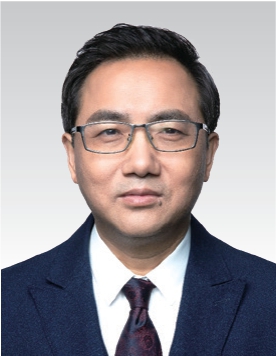
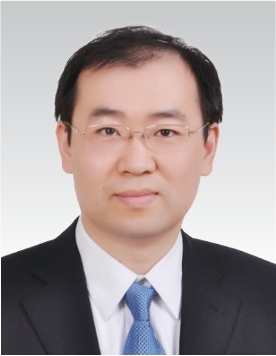




Received: 15 November 2021/Accepted: 6 May 2022/Published: 25 June 2022
Chunyan Zhang zcytongji@126.com
Zhenlan Dou douzhenlan@hotmail.com
Wei Wang wang-w@geidco.org
Dan Wang wangdantjuee@tju.edu.cn
Qiqi Zhang sh_kjjl@163.com
Yanxing Cai 1336621286@qq.com
Ruitian Fan 996308004@qq.com
2096-5117/© 2022 Global Energy Interconnection Development and Cooperation Organization.Production and hosting by Elsevier B.V.on behalf of KeAi Communications Co.,Ltd.This is an open access article under the CC BY-NC-ND license (http://creativecommons.org/licenses/by-nc-nd/4.0/).
Biographies
Zhenlan Dou received Ph.D.degree at Shanghai Jiaotong University in 2013.She is working in State Grid Shanghai Integrated Energy Service Co.,Ltd.Her research interests include Integrated Energy System.
Chunyan Zhang received M.S.degree at Tongji University in 1995.He is working in State Grid Shanghai Integrated Energy Service Co.,Ltd.His research interests include Integrated Energy System.
Wei Wang received the PhD degree from North China Electric Power University in 2007.He is a professorate senior engineer and senior economist.he is a senior member of Chinese Society for Electrical Engineering,two members of national standardization technical committee on distributed energy and microgrid(SAC/TC564) and smart grid user interface(SAC/TC549).His research focuses on smart grid,renewable energy integration,energy storage and energy internet.
Dan Wang received Ph.D.degree at Tianjin University in 2009.He is working in Tianjin University His research interests include integrated energy system,intelligent power distribution system,distributed generation and microgrid system.
Qiqi Zhang received M.S.degree at Shanghai Jiaotong University in 2010.She is working in State Grid Shanghai Municipal Electric Power Company.Her research interests include smart grid,energy internet.
Yanxing Cai received bachelor’s degree at Shanghai University of Electric Power,Shanghai,China in 2019 and he is now a graduate student at Shanghai University of Electric Power.His research interests include integrated energy and detection and control of electrical system.
Ruitian Fan is now a graduate student at Shanghai University of Electric Power.His research interests include integrated energy and detection and control of electrical system.
(Editor Dawei Wang)
